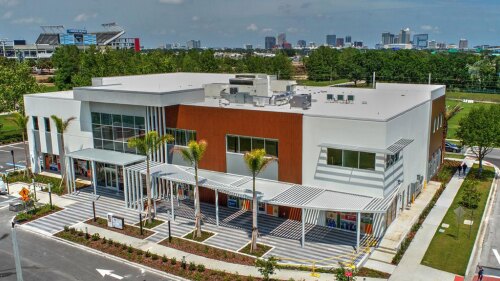A talented and loyal team, a pragmatic and flexible approach, and an emphasis on complex, transit-oriented, mixed-use projects have served developer JBG well in carving out a niche through nearly a half century of real estate cycles—offering valuable lessons for real estate organizations everywhere.
It is almost impossible to walk around urban Washington, D.C.— particularly the areas surrounding Metrorail stations—without seeing the lion’s-head logo of the JBG Companies. From Southeast Federal Center and L’Enfant Plaza in the District of Columbia, to Twinbrook Metro Park and the Veridian apartments at the Silver Spring Metro in Maryland, to Rosslyn’s Waterview and Ballston’s Arlington Gateway in Virginia, JBG’s presence is felt throughout the area. Since its founding in 1960, the company has become a major influence in metropolitan Washington real estate, as well as one of the region’s most active and respected real estate organizations.
At one level, JBG’s owners credit the firm’s ongoing success to their focus on creating value for investors by embracing a full-service approach, in terms of both the product lines and the services the firm offers— services that include investment, property, and development management, as well as commercial leasing. At a more organic level, the owners credit the firm’s current vitality to its ability to manage two important elements of transition: a transformation of its capital platform, and a transition in ownership and management that provides continuity of the firm’s culture and stability for its future.
JBG initially functioned as a classic development company, obtaining capital and financing for each new project in an opportunistic manner. Over time, the firm has evolved into much more of an investment manager that continues to provide a broad range of services to investors, including a full complement of development and operational capacities. JBG’s experiences carving out a niche for itself in a strong but increasingly competitive market offer valuable lessons for real estate organizations everywhere.
Those who have partnered and invested with JBG over the years invariably cite a number of factors when asked why they continue to work with the firm. John T. “Terry” Beaty, Jr., a senior partner with Brown Advisory who has invested, both personally and on behalf of clients, with JBG since the 1970s, lists five: the company’s reputation for integrity, its depth of talent and leadership, its deep knowledge of the local real estate market, its unusually broad development capabilities, and its financial strength. These factors, as well as a corporate culture that seeks out young talent and “grows its own” future generations of leaders, have enabled the firm, now in its 50th year, to strategically position itself as a legacy company that expects to expand and seek out new opportunities well into the future.
The JBG Companies had its genesis in a law firm founded in the 1950s. By 1960, that firm’s partners realized they were doing more real estate work than law, and two of them—Donald Brown and Joe Gildenhorn, along with their associate Ben Jacobs, created JBG Associates as a real estate development and investment firm. JBG’s early projects were developed under separate limited partnerships and financed with equity raised from a variety of sources—primarily high-net-worth individuals and institutions. Early on, JBG also formed a management division to manage its properties, as well as some owned by others. One significant legacy from its beginnings as a law firm was that JBG’s founders viewed the company as more than simply a developer or an asset manager. Rather, they viewed their firm as providing a broad range of services to a wide range of clients. This early orientation continues to be an important focus for JBG.
While the company began by developing office projects, JBG gradually expanded into residential (apartment and condominium), hotel, and retail properties. Over the years, as the size and number of JBG’s development projects grew, it continued to capitalize these transactions on a project-by-project basis. In the early 1980s, the firm’s leaders made a conscious effort to begin focusing on the acquisition of existing assets rather than exclusively on new development. Through the end of the decade, the firm pursued a strategy that combined acquisitions with development. Most commonly, JBG would research and purchase a well-located structure or complex built in the 1960s or 1970s that was leased— sometimes by a federal agency—and producing enough income to cover its carrying costs while the firm explored redevelopment options, assembled additional properties, worked with the city or county on any necessary zoning changes, and ultimately redeveloped the property. This approach limited risks for JBG and its investors, and resulted in a steady rate of return.
JBG also began to grow a fee development business. “Our feeling was that we were growing a development staff, and creating a fee-based development business as a significant component of the company was a way to keep that development bench busy and productive—and help pay our overhead—through different market cycles,” notes Mike Glosserman, a managing member of JBG Holding Company.
This expanded scope prepared the firm well for the major real estate recession that began in the late 1980s. Although institutional investors had generally abandoned the market, JBG’s high-net-worth investors maintained their confidence in JBG and continued to invest with the firm, enabling JBG to return to the market in 1991, when few other companies had the financial wherewithal to do so. This proved fortuitous for JBG because it allowed the firm to acquire a portfolio of significant properties at what proved to be excellent values.
By the mid-1990s, several changes in the real estate world were beginning to have a major impact on JBG. Many real estate firms that were in financial difficulty had gone public and become real estate investment trusts (REITs), which gave them ready access to public-market money. The opportunity funds that had been so active in the 1980s also had returned to the real estate market. These occurrences led JBG’s owners to conclude that, in order to sustain the velocity of its investment activities, the firm would need to raise discretionary money to capitalize future projects. They sought expert advice from a variety of financial advisers and repeatedly were urged to go public. But JBG’s owners had no interest in doing so. Instead, they decided to sell most of the company’s commercial and development portfolio, which consisted primarily of office properties. In early 1998, JBG sold the bulk of that portfolio to TrizecHahn Corporation for nearly $600 million.
The transaction was a turning point for JBG. The number of employees in the corporate office shrank from hundreds to only nine. JBG was left with a portfolio of a few thousand multifamily residential units and a significant ownership share in the JBG Rosenfeld retail group, a stand-alone company with its own staff that acts as JBG’s retail arm.
After the portfolio sale, JBG’s leaders began raising money for the firm’s first discretionary investment fund. They used the $28 million fund—composed exclusively of money from taxable individuals— along with their own money to coinvest in real estate projects with several institutional partners. The market was steadily improving, and the company soon raised a second fund. JBG’s leaders quickly realized that their opportunity set required much larger pools of capital and that they would need to appeal to institutional investors as well as individuals. Soon thereafter, the investment arm of a leading university endowment became JBG’s first institutional partner as the lead investor in JBG’s third fund, which totaled more than $200 million. Subsequent funds continued to grow in size, with additional university endowments investing in the fifth and sixth funds.
By 2008, with the closing of the seventh, $600 million fund, JBG’s investors included additional endowments, an expanding pool of taxable investors, and, for the first time, foundations. Reviewing that fund’s closing, Matt Kelly, a member of JBG’s executive committee and a director of the firm’s investment management activities, observes: “We were extremely fortunate to have such a loyal group of investors in one of the worst fundraising environments any of us has ever seen. While many of them were liquidity constrained, their proactive referrals and unwavering support enabled us to attract several well-regarded foundation investors and allowed us to hit our target in an extremely challenging capital environment.”
Lawrence Nussdorf, president and COO of Clark Enterprises, which has worked with JBG for more than 40 years, has seen how JBG’s capital strategies have benefited the firm. “Remaining private rather than becoming a REIT has allowed JBG the flexibility to take advantage of multiple real estate opportunities rather than being constrained by having to make sure every project can be explained to a Wall Street analyst,” he says. The company’s strategies continue to serve it well during the current real estate recession. Its Class A list of investors sets it apart from many other firms in its ability to negotiate with lenders. In August 2007, JBG sold a portfolio containing 93 of its development assets in a multibillion-dollar transaction to a new joint venture called JBG Urban LLC. This JBG joint venture is a partnership with McFarlane Partners—which invested on behalf of its own fund and through a venture for the California Public Employees’ Retirement System (CalPERs)—and a fund managed by Morgan Stanley Real Estate. The sale has given JBG the ability to continue to develop and operate these assets within the context of creating value in a large portfolio over an extended period of time.
Governance and Transitions
The JBG Companies is run as a highly collaborative organization, which Glosserman sees as reflective of its beginnings as a law firm. While the composition of its executive committee—JBG’s governing group— has changed over time, no significant decision is made without an overwhelmingly strong consensus of the committee. Over the years, that group has spent a considerable amount of time addressing inevitable transitions in leadership and the evolution of the firm.
The founding partners recognized early on that to attract the best employees, they would have to offer new associates significant opportunities for professional and personal growth—a decision that required them to dilute their own financial interests in the firm, but that ultimately has made it stronger and more profitable for all. In the mid- and late 1970s, they brought in the second generation of owner/leaders, Bob Braunohler, Lew Rumford, and Glosserman. The six partners led JBG into the 1980s, when they began bringing in a third generation of owner/leaders. While Jacobs remains actively involved on a day-to-day basis, Brown, Gildenhorn, Braunohler, and Rumford have retired from the organization. The firm has continued to promote new owner/leaders in every succeeding decade, and JBG now has 11 capital shareholders and seven additional shareholders.
“The ability of each generation of leaders to exemplify the company’s core values and fit into its corporate culture—a culture based on competence, integrity, and the ability to respect and support one another— has been a key factor in the company’s success,” notes Porter Dawson, JBG’s chief operating officer. A great deal of decision making is delegated to teams whose members are given an enormous amount of autonomy and authority in executing the firm’s projects. This challenging environment allows young associates to develop the skills and experience needed to grow into senior leadership positions. And JBG’s status as a private but not family-owned firm provides much broader opportunities for personal and professional growth—a clear advantage when it comes to retaining talented staff.
“We sometimes call ourselves a ‘gentle meritocracy’ in that we’re quick to reward talented individuals with great responsibility, regardless of age or tenure,” says James Iker, a member of JBG’s executive committee and a director of the firm’s investment management activities. “At the same time, we have taken great pains to create a collaborative culture by aligning incentives across the firm and promoting broad employee participation in our investments. This approach of ‘growing the pie by sharing it’ has paid tremendous cultural and financial dividends for our company.”
Responding to Change
JBG also has made carefully thought-out changes in the types of projects it acquires and develops. Nussdorf notes that the firm was among the first in the region to recognize the importance of transportation access in terms of value creation. Focusing on properties that are accessible by Metrorail, located inside the Capital Beltway, and/or near intersections of primary roadways has enabled JBG to acquire and redevelop some of the most valuable real estate in the metropolitan area. Developing complex mixed-use projects on these sites has allowed the firm to take a holistic and flexible approach to each site, exploring which combination of elements works best in which particular configuration—an approach that has helped it be particularly responsive to changing market conditions. In addition, JBG has partnered with other companies to include product types in which it does not have in-house expertise— working, for example, with local developers EYA and Scheer Partners to develop projects that incorporate townhouses and laboratory space, respectively.
As part of its continuing commitment to enhancing the area’s built environment, JBG has a history of working with well-known architects, including Skidmore, Owings & Merrill; Pei Cobb Freed & Partners; Michael Graves & Associates; and Pelli Clarke Pelli Architects. In 2004, for example, JBG leaders began talking with the Richard Rogers Partnership (now Rogers Stirk Harbour + Partners) about a design for a new Washington, D.C., office building at 300 New Jersey Avenue. Those conversations resulted in a strong collaborative relationship between the two firms and led to JBG’s development of a dramatic addition to the city’s streetscape that also was the London-based company’s first built U.S. project in 25 years.
“From our first meeting, we clicked,” architect Ivan Harbour, who served as project director for 300 New Jersey, says of why the process worked so well. “It was very clear that we were talking with a team, and that was important to us. We enjoy a client who likes collaborating and isn’t just simply asking for an icon or an image, but who actually wants to work with us. We’re kindred spirits.”
JBG’s leaders also continue to seek out and take advantage of new opportunities in the marketplace. “We think there are so many opportunities in the Washington metro area that we haven’t found any compelling reasons to step outside of this market,” says Brian Coulter, JBG’s chief development officer. The firm’s leaders remain committed to continually improving the metro area’s built environment; to creating value for their investors, partners, tenants, and employees; and to maintaining the firm’s reputation as one of the most effective and respected local operators in what remains one of the most attractive and active real estate markets in the nation.




